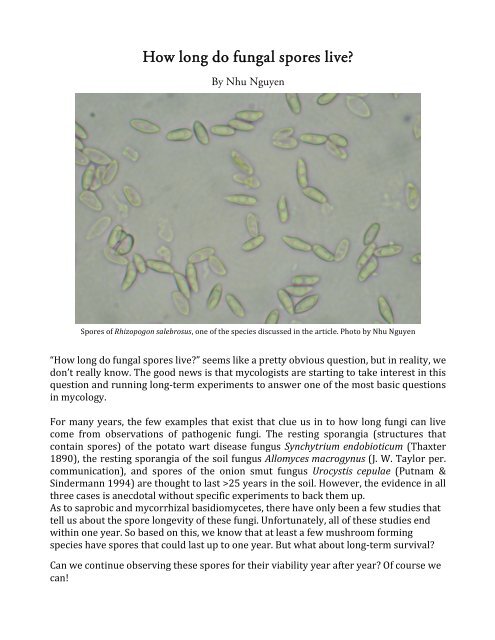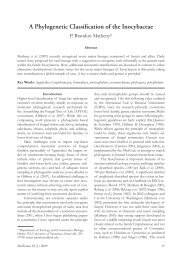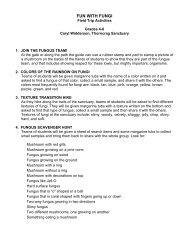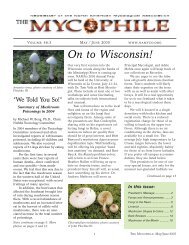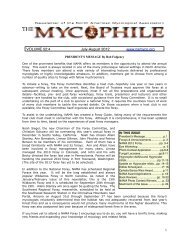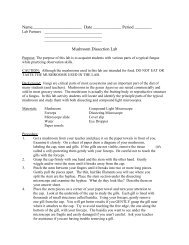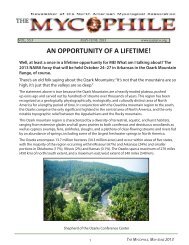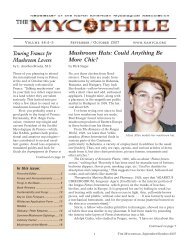How long do fungal spores live?
How long do fungal spores live?
How long do fungal spores live?
Create successful ePaper yourself
Turn your PDF publications into a flip-book with our unique Google optimized e-Paper software.
<strong>How</strong> <strong>long</strong> <strong>do</strong> <strong>fungal</strong> <strong>spores</strong> <strong>live</strong>?<br />
By Nhu Nguyen<br />
Spores of Rhizopogon salebrosus, one of the species discussed in the article. Photo by Nhu Nguyen <br />
<br />
“<strong>How</strong> <strong>long</strong> <strong>do</strong> <strong>fungal</strong> <strong>spores</strong> <strong>live</strong>?” seems like a pretty obvious question, but in reality, we <br />
<strong>do</strong>n’t really know. The good news is that mycologists are starting to take interest in this <br />
question and running <strong>long</strong>-‐term experiments to answer one of the most basic questions <br />
in mycology. <br />
For many years, the few examples that exist that clue us in to how <strong>long</strong> fungi can <strong>live</strong> <br />
come from observations of pathogenic fungi. The resting sporangia (structures that <br />
contain <strong>spores</strong>) of the potato wart disease fungus Synchytrium en<strong>do</strong>bioticum (Thaxter <br />
1890), the resting sporangia of the soil fungus Allomyces macrogynus (J. W. Taylor per. <br />
communication), and <strong>spores</strong> of the onion smut fungus Urocystis cepulae (Putnam & <br />
Sindermann 1994) are thought to last >25 years in the soil. <strong>How</strong>ever, the evidence in all <br />
three cases is anec<strong>do</strong>tal without specific experiments to back them up. <br />
As to saprobic and mycorrhizal basidiomycetes, there have only been a few studies that <br />
tell us about the spore <strong>long</strong>evity of these fungi. Unfortunately, all of these studies end <br />
within one year. So based on this, we know that at least a few mushroom forming <br />
species have <strong>spores</strong> that could last up to one year. But what about <strong>long</strong>-‐term survival? <br />
Can we continue observing these <strong>spores</strong> for their viability year after year? Of course we <br />
can!
In 2004, Tom Bruns at UC Berkeley took on the challenge of trying to figure out how <br />
<strong>long</strong> <strong>spores</strong> of ectomycorrhizal fungi could <strong>live</strong> in the soil (Bruns et al. 2009). He picked <br />
four Rhizopogon species (R. occidentalis, R. salebrosus, R. vulgaris, and R. <br />
olivaceotinctus), extracted the <strong>spores</strong>, and sprayed them onto soil that has no <br />
Rhizopogon <strong>spores</strong>. The soil/spore mixtures were packed in terracotta pots, covered <br />
with terracotta saucers, tied, and buried in a tree-‐less area at Point Reyes National <br />
Seashore. The reason for this was so that he could emulate the natural conditions that <br />
the <strong>spores</strong> would face in nature. These pots of soil would remain buried for 99 years. <br />
Each year for the first 4 years, we unearthed a pot of soil from each species, the <br />
soil/spore mixture within was mixed with sterile soil, and pine seedlings were planted <br />
in them. We grew the seedlings for six months and then examined the roots for <br />
colonization of Rhizopogon. We initially hypothesized that the <strong>spores</strong> would die off over <br />
time but the experimental evidence was contrary. We found that the <strong>spores</strong> actually <br />
became more a<strong>live</strong> over time! But what <strong>do</strong>es becoming more a<strong>live</strong> mean? <br />
What it means is that most of these <strong>spores</strong> start out being <strong>do</strong>rmant, and they wake up <br />
over time. Analogous to a seed, a <strong>do</strong>rmant spore cannot germinate and can only grow <br />
and partner with a seedling root after it had awaken from <strong>do</strong>rmancy. Thus, a <br />
consequence of this <strong>do</strong>rmancy means that the <strong>spores</strong> lay in the soil for years, waiting for <br />
the moment when by chance a pine seed would drop onto the soil and germinate. It is <br />
only then that the spore will germinate and form mycorrhizae with the seedling. This <br />
idea is a<strong>long</strong> the same lines of thought as a “seedbank”, where a seed lays <strong>do</strong>rmant in the <br />
soil and waits for the proper conditions before it germinates. We call the waiting of <br />
<strong>spores</strong> in the soil for proper a condition to germinate a “sporebank”. <br />
What about other species of ectomycorrhizal fungi? Do they behave the same way as <br />
Rhizopogon and produce a sporebank? To answer this question, Tom collected forest <br />
soil (which we thought contained <strong>spores</strong> of many species), put them into terracotta <br />
pots, and buried them. After 6 years, we dug up these pots, planted seedlings in the soil <br />
and identified the species that have colonized the roots. As expected, <strong>spores</strong> of <br />
Rhizopogon species, particularly R. vulgaris and R. salebrosus could survive up to 6 years. <br />
The surprise came from the fact that Suillus brevipes could also survive up to 6 years in <br />
the soil. Even though Suillus is closely related to Rhizopogon, their fruiting structure <br />
(mushroom in Suillus vs. truffle in Rhizopogon) and the way they disperse their <strong>spores</strong> <br />
(wind in Suillus vs. rodents in Rhizopogon) are different. We only expected the rodent <br />
dispersed species to be resistant through time, but the results of this experiment proved <br />
otherwise. <br />
So, all of these results together tells us that <strong>spores</strong> of suilloid ectomycorrhizal species <br />
can form a sporebank and remain a<strong>live</strong> in that sporebank for at least 6 years. Of course <br />
this is only the first 6 years of the experiment. We still have 93 years to go! Tom <br />
considered sticking around until the experiment is <strong>do</strong>ne.
References <br />
Bruns TD, Peay KG, Boynton PJ, Grubisha LC, Hynson NA, Nguyen NH, Rosenstock NP, 2009. <br />
Inoculum potential of Rhizopogon <strong>spores</strong> increases with time over the first 4 yr of a 99-‐yr spore <br />
burial experiment. New Phytologist 181: 463-‐70. <br />
Nguyen NH, Hynson NA, Bruns TD. 2012. Stayin’ A<strong>live</strong>: survival of mycorrhizal <strong>fungal</strong> <br />
propagules from 6-‐yr-‐old forest soil. Fungal Ecology. In press. <br />
Putnam ML, Sindermann AB, 1994. Eradication of potato wart disease from Maryland. <br />
American Potato Journal 71: 743–747. <br />
Thaxter R, 1890. The smut of onions (Urocystis cepulae Frost). Connecticut Agricultural <br />
Experiment Station Annual Report 1890: 127–154. <br />
<br />
About the Author: <br />
Nhu Nguyen is a PhD candidate at UC Berkeley studying under Tom Bruns. He enjoys <br />
collecting and eating mushrooms (the edible ones of course), describing new <strong>fungal</strong> <br />
species, and photography of plant and fungi. His research interest is in symbiotic <br />
interactions between fungi and other organisms. For more of his work, see his web page <br />
at http://www.flickr.com/photos/xerantheum/


